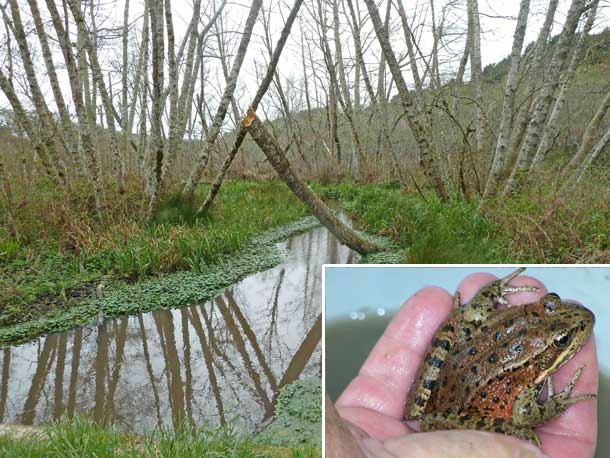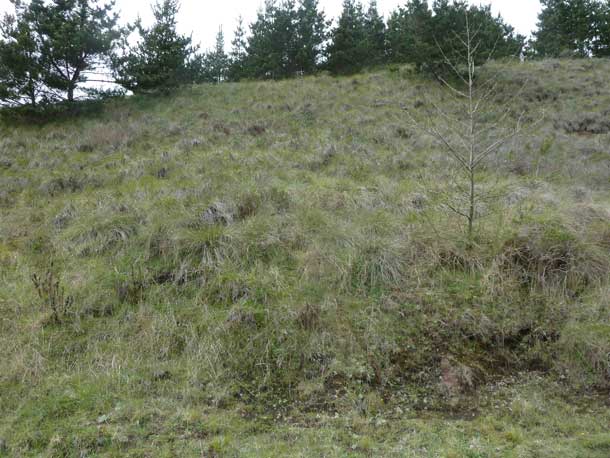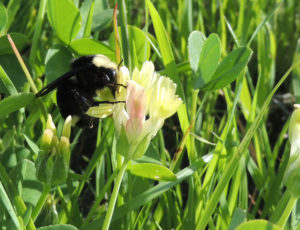Check out this and other hikes Jules has taken on this Google map. The most recent hike is in blue; others are in red.
Length: 5.0 miles. Hiked on March 20, 2012
Trail notes: This five mile loop follows the riparian corridor of Laguna Creek downstream past a freshwater marsh, tracing the hind-dunes as it parallels Limantour Beach to Coast Camp, then swings back through northern coastal scrub and climbs uphill across some craggy hogbacks then back down hill toward the American Youth Hostel. The first two and a half miles are an easy stroll; the last half is moderately strenuous. Sections can be muddy and slippery after rainy periods.
Conditions: Cool (55°F), overcast, negligible breeze.
My wife, Meryl, and I were “house parents” at the Point Reyes Hostel in the late 1970s, so this hike brings back some memories. On January 1, 1980, our first child was one week old and I was out for a morning run down the Coast Trail, four miles round trip to the beach and back. That cloudy morning I was about half a mile into the run when a mountain lion crossed the trail, about 50 yards ahead of me. Apparently I saw her before see sensed me, but when I lay down in the road to reduce my profile and get a longer look, she turned her head slowly in my direction, considered me for about a second, then disappeared into the tall grasses along side the trail. I think of that brief encounter every time I walk this path.
-
Native gasses along Coast Trail Caption: The hillside where the mountain lion vanished from view, covered in native bunchgrasses, probably California fescue (Festuca californica). Native grasslands like this are now rare in the state, having been converted from perennial to annual grasslands with the introduction of European grasses and bovines. Where grazing has ceased and the soils are not too disturbed, perennial grasses may reestablish, yet another contribution to biodiversity provided by protected areas like the Philip Burton Wilderness through which the Coast Trail travels Photograph by Jules Evens.
Among the native grasses on the slope we notice a little colony of my favorite spring wildflowers, one of the mariposa lilies (“butterfly lilies”) in the genus Calochortus (from the Greek “beautiful grass”). This species is known a “pussy-ears,” or ‘hairy star tulip,” perhaps the most fetching of the 28 species in California. (California is the center of diversity for this genus.) Pussy-ears bloom from bulbs every spring, usually found from late-March through April, on moist grassy slopes along the immediate coast. The grassy hillside on the south side of the trail near the mouth of Laguna Canyon offers prime habitat.

-
Pussy ears (Calochortus tolmei), named for the hairy petals, “pubescent” in botanical terminology. Photograph by Jules Evens.
The calochortus lily is a libertine when it comes to pollinators–accepting one and all. Bumblebees are abundant in early spring, and the species seen most frequently, visiting manzanita, rosemary, and lilies like these. The one I think I see most frequently is on the “yellow-headed” species.
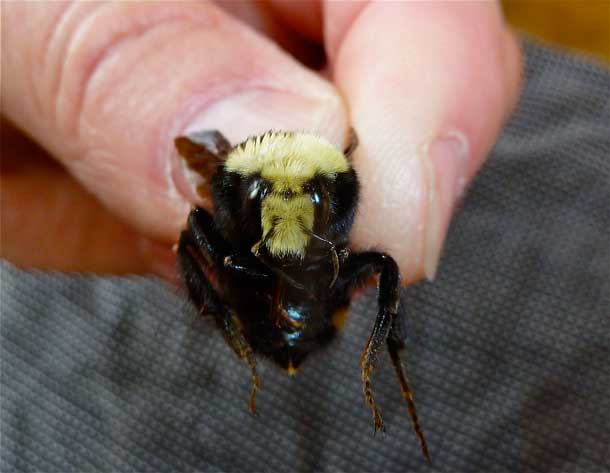
-
The yellow-headed bumblebee, Bombus vandykei, pictured here, seems to be the most common of the several bumblebee species we find here in coastal California. I wonder if the name vandykei refers to the goatee-like pattern of the facial covering? Photograph by Jules Evens/
Another western species (B. occidentalis), once common from southern British Columbia to central California, has nearly disappeared. Something is alarmingly amiss if we are losing some of our most productive pollinators. According to the Xerces Society, the recent precipitous decline in native bumblebees seems to have been caused be recently introduced nonnative fungal and protozoan parasites, probably introduced when colonies of North American bumble bees were reared in Europe then imported to the U.S. for commercial greenhouse pollination.
Identifying the western bumblebees to species is a challenge, a bumble conundrum. (Check out these resources from the Xerces Society.)
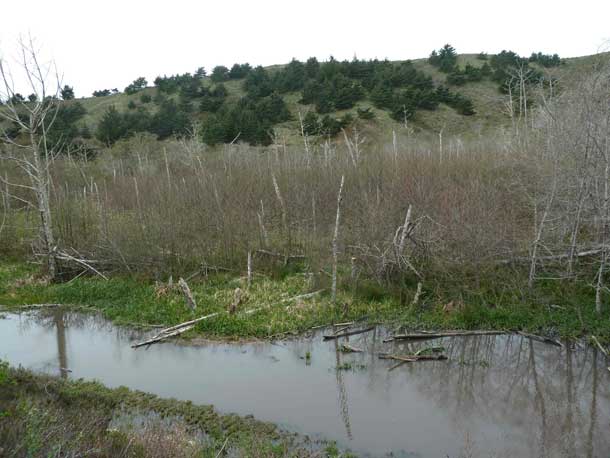
-
Laguna Marsh, a dying alder grove, progressing toward the natural succession to willows. Photograph by Jules Evens.
Near the mouth of Laguna Canyon, Coast Trail crosses Laguna Creek. This riparian wetland received a massive deposition of decomposed granite during the floods of the early 1980s. Shortly thereafter, red alders (Alnus rubra) colonized the floodplain and went about their work of channelizing the creek and fixing nitrogen and nutrifying the soil. Now, 30-plus years later, the alder grove, having completed its mission, is dying off. And so it goes.
Farther along, the trail veers south to bypass Laguna Marsh, paralleling the dunes that border Limantour Beach. The marsh is heavily vegetated with cattails and tules, prime habitat for Virginia rail, marsh wren, common yellowthroat, song sparrow, and California red-legged frog. A pair of northern harriers, or “marsh hawks,” are in courtship display, a parallel roller-coaster flight above the cattails and bulrushes. (Perhaps this playful flight accounts for the genus name, Circus?) The browner, streakier, and slightly larger female wheels over an area she has selected for a nest site, showing the gray and white male the spot. He then circles, checking us out.
After arriving at the cut-off to Coast Camp, Laguna Trail veers left and climbs the slippery marl on the south slope of a rather steep hogback. The canyon to the south offers a view of post-fire habitat, a steep slope covered in a thick forest of blue blossom or wild liliac (Ceonothus thyrsifolia) that will come into full violet bloom later in the spring.
As we come to the last mile of the hike, a slippery descent down Laguna Trail, a distant sound catches our attention and we stop to listen. It’s late afternoon, and the slant of light is just beginning to change. A single coyote howl, not the maniacal yipping often heard from packs, but a more plaintive bay, drawn out, probably a lone individual calling to a mate, or searching for one.
Excellent end to an excellent hike.

-
Marsh monkeyflower (Mimulus guttatus) a common indicator of wetland swales, grows in profusion in the upper reaches of Laguna Marsh. The species’ name, guttatus, means “speckled” in Latin, in reference to the red spotting on the throat of the flower, nectar guides for pollinators like bumblebees. Photograph by Jules Evens.
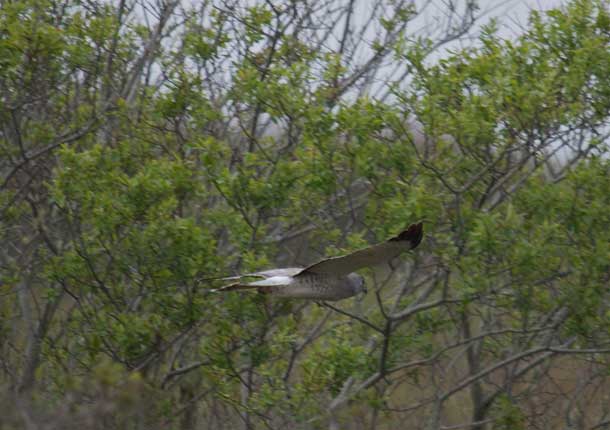
-
Male northern harrier, a resident of damp lowland grasslands and swales, is particularly common on the peninsula as compared to other areas. The relatively long, black-tipped wings and the diagnostic white “saddle” identify this raptor as a harrier; the gray dorsal coloring as a male. The slightly larger female is brown above. Photograph by Jules Evens.

